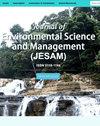Estimation of Basic Wood Density and its Uncertainty for Quercus Species in South Korea
IF 0.3
4区 环境科学与生态学
Q4 ENVIRONMENTAL SCIENCES
引用次数: 1
Abstract
Basic wood density is recommended by the Intergovernmental Panel on Climate Change as one of the parameters that can accurately estimate carbon stocks of trees. This study was conducted to estimate the basic wood density of Quercus acutissima, Quercus mongolica, Quercus serrata, and Quercus variabilis in South Korea and to determine their uncertainty. Water displacement method was used to determine the fresh volume of the cubic specimen without bark while the oven-dry weight was determined through oven-drying with a temperature of 85°C until it reached the constant weight. The basic wood density and uncertainty were 0.695 g cm-3 and 2.59% for Q. acutissima, 0.663 g cm-3 and 3.33% for Q. mongolica, 0.664 g cm-3 and 6.60% for Q. serrata and 0.721 g cm-3 and 1.66% for Q. variabilis, respectively. Analysis of variance showed that there is a significant difference in terms of the basic wood density of the four Quercus species (p<0.001). The results of this study on the basic wood density and uncertainty of the different Quercus species are essential in providing accurate information for estimating the biomass of Quercus forests.韩国栎属树种基本木材密度的估算及其不确定性
政府间气候变化专门委员会建议将基本木材密度作为可以准确估计树木碳储量的参数之一。本研究旨在估算韩国麻栎、蒙古栎、锯齿栎和栓皮栎的基本木材密度,并确定其不确定性。用水置换法测定不含树皮的立方体试样的新鲜体积,同时通过在85°C的温度下烘箱干燥直到达到恒定重量来测定烘箱干燥重量。麻麻的基本木材密度和不确定度分别为0.695 g cm-3和2.59%,蒙古木的基本木材浓度和不确定率分别为0.663 g cm-3、3.33%,锯齿木的基本密度和不确定性分别为0.664 g cm-3及6.60%,可变木的基本木密度和不确定性分别为0.721 g cm-3与1.66%。方差分析表明,四种栎属植物的基本木材密度存在显著差异(p<0.001)。本研究对不同栎属植物基本木材密度和不确定性的研究结果对于为估算栎林生物量提供准确信息至关重要。
本文章由计算机程序翻译,如有差异,请以英文原文为准。
求助全文
约1分钟内获得全文
求助全文
来源期刊

Journal of Environmental Science and Management
ENVIRONMENTAL SCIENCES-
CiteScore
0.90
自引率
0.00%
发文量
10
审稿时长
2 months
期刊介绍:
The Journal of Environmental Science and Management (JESAM) is an international scientific journal produced semi-annually by the University of the Philippines Los Baños (UPLB).
JESAM gives particular premium to manuscript submissions that employ integrated methods resulting to analyses that provide new insights in environmental science, particularly in the areas of:
environmental planning and management;
protected areas development, planning, and management;
community-based resources management;
environmental chemistry and toxicology;
environmental restoration;
social theory and environment; and
environmental security and management.
 求助内容:
求助内容: 应助结果提醒方式:
应助结果提醒方式:


